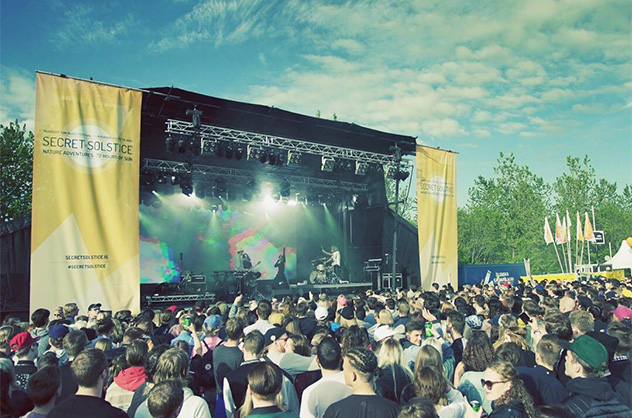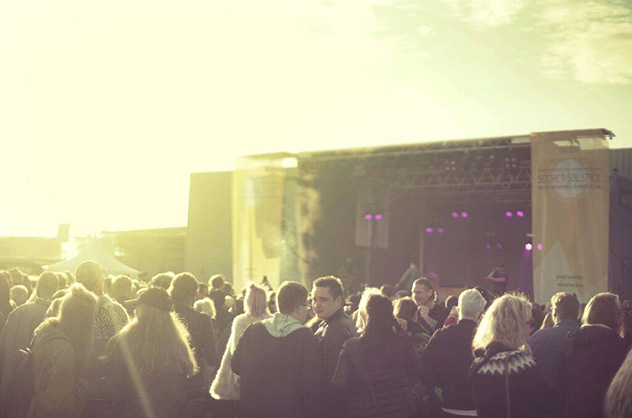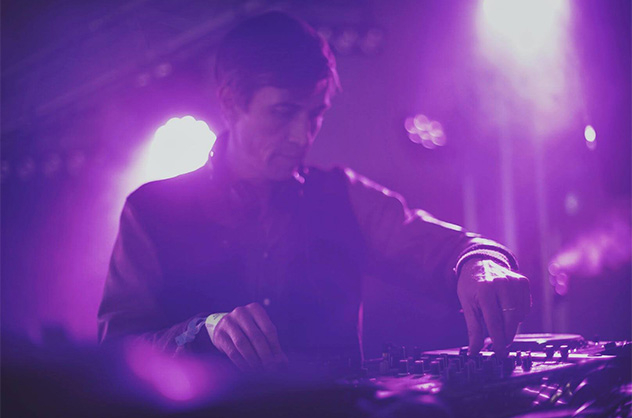- Secret Solstice is Iceland's only major summer music festival, and in one respect it's Europe's most unique. Summer days—and winter nights—on the island are notably long, and during the solstice the sun only sets for a couple of hours, meaning that the whole country is bathed in continuous daylight throughout the third week of June. The sun's persistence messes around with your sense of time (and your sleeping pattern), but it also pushes your body to keep going—ideal conditions for a three-day party. The hours seem frozen in time, and yet they accelerate in the apparent stillness of the daylight.
The festival took place in Þróttur Reykjavík, a sports complex adjacent to the city's highway, across three main stages and several compact, rectangular tents. Secret Solstice expanded on its dance music lineup for its second edition, drafting in acts like Moodymann, Green Velvet, Daniel Avery and Tale Of Us to play across two dedicated arenas alongside other stages that turned the spotlight on Iceland's formidable music scene.
What struck me about many of the Icelandic artists, irrespective of genre, was the immediacy and physicality of the music. This was true of well-established rock bands like Dr Spock and HAM, the former of whom, led by singer and Icelandic MP Óttarr Proppé, played out a theatrical thrash of punk-funk and metal with a Vaudeville flourish that drowned out the house music of the neighbouring tents. Equally, Iceland's burgeoning hip-hop scene was at the centre of much of the festival. If the dance music, topping and tailing each day, formed the spine of the festival's programming, then rappers like Gisli Palmi and Tiny were right at the heart of things.
 Inevitably, there were nods to US sounds and aesthetics. GKR, a youthful trio dressed all in white, chewed over trap snares, blockbuster melodies and witch house atmospheres in the Fenrir tent, which housed most of the festival's hip-hop. Accomplished as they were, I was more taken by Reykjavíkurdætur, or Daughters Of Reykjavik, a feminist rap collective of up to 21 members who played on Sunday afternoon in the same arena. Appearing just two days after Iceland celebrated 100 years of female suffrage, 16 members crammed onto the stage, rapping, singing and screaming in crunching consonants and cooing vowels, mocking "hey, baby" chat-up lines and the male anatomy (one of the crew briefly wore a sparkly silver strap-on).
In retrospect, a festival whose local acts were defined by their directness may not have been the best setting for a collective like Life And Death, who had the Askur stage to themselves for most of Friday. Revellers who took in Thugfucker seemed more entranced by the yellow, beach ball-sized balloons bouncing across the crowd than the music, and Mind Against struggled to keep dancers interested with a spartan, synth-laced set of house and techno. Gus Gus's dark-tinted fusion of pop and electronic music is made up of the same sort of stuff, but, when I saw them later that evening on the main stage, it felt much more urgent and affecting.
Inevitably, there were nods to US sounds and aesthetics. GKR, a youthful trio dressed all in white, chewed over trap snares, blockbuster melodies and witch house atmospheres in the Fenrir tent, which housed most of the festival's hip-hop. Accomplished as they were, I was more taken by Reykjavíkurdætur, or Daughters Of Reykjavik, a feminist rap collective of up to 21 members who played on Sunday afternoon in the same arena. Appearing just two days after Iceland celebrated 100 years of female suffrage, 16 members crammed onto the stage, rapping, singing and screaming in crunching consonants and cooing vowels, mocking "hey, baby" chat-up lines and the male anatomy (one of the crew briefly wore a sparkly silver strap-on).
In retrospect, a festival whose local acts were defined by their directness may not have been the best setting for a collective like Life And Death, who had the Askur stage to themselves for most of Friday. Revellers who took in Thugfucker seemed more entranced by the yellow, beach ball-sized balloons bouncing across the crowd than the music, and Mind Against struggled to keep dancers interested with a spartan, synth-laced set of house and techno. Gus Gus's dark-tinted fusion of pop and electronic music is made up of the same sort of stuff, but, when I saw them later that evening on the main stage, it felt much more urgent and affecting.
 The Hel stage, a huge indoor ice rink bathed in red light, housed the festival's dance music from 11 PM onwards. Marquee names like Skream, Green Velvet and Heidi headlined the arena across the weekend, but many of them fell short of delivering the magic to accompany the scale. "I can take you higher," Green Velvet intoned to the audience during his Friday night set, but he did so through sheer force of will rather than a genuinely persuasive set of tracks. I found Heidi's set a bit of a trudge, too. Her techno-centric selections filled the vast arena well enough, but it often felt too heavy-handed—Radio Slave and Thomas Gandey's remix of Aphrohead's "Let's Prance" offered a rare moment of levity to an otherwise flat session. Only Daniel Avery's disorienting fug of acid and outer space noise, closing the festival on Sunday, seemed to cast a spell on an exhausted but willing crowd.
Many of my favourite moments were more intimate encounters. Detroit Swindle and Moodymann drew a lot of sweat out of their respective crowds on Saturday, the former tracing a bumpy line through Motor City house classics like Underground Resistance's "Hardlife," while the latter threw together luxuriant disco records with Kyle Hall and Kero's "Zug Island." On Sunday, I stayed for a good hour of KiNK's live set, which weaved together piano shards of UR classics and Aretha Franklin vocals with thumping drum tracks. Looking over the tossed hats and backflips that took place below, the Bulgarian's head and shoulders twitched with the same indomitable pulse of a dance floor many others struggled to win over.
The Hel stage, a huge indoor ice rink bathed in red light, housed the festival's dance music from 11 PM onwards. Marquee names like Skream, Green Velvet and Heidi headlined the arena across the weekend, but many of them fell short of delivering the magic to accompany the scale. "I can take you higher," Green Velvet intoned to the audience during his Friday night set, but he did so through sheer force of will rather than a genuinely persuasive set of tracks. I found Heidi's set a bit of a trudge, too. Her techno-centric selections filled the vast arena well enough, but it often felt too heavy-handed—Radio Slave and Thomas Gandey's remix of Aphrohead's "Let's Prance" offered a rare moment of levity to an otherwise flat session. Only Daniel Avery's disorienting fug of acid and outer space noise, closing the festival on Sunday, seemed to cast a spell on an exhausted but willing crowd.
Many of my favourite moments were more intimate encounters. Detroit Swindle and Moodymann drew a lot of sweat out of their respective crowds on Saturday, the former tracing a bumpy line through Motor City house classics like Underground Resistance's "Hardlife," while the latter threw together luxuriant disco records with Kyle Hall and Kero's "Zug Island." On Sunday, I stayed for a good hour of KiNK's live set, which weaved together piano shards of UR classics and Aretha Franklin vocals with thumping drum tracks. Looking over the tossed hats and backflips that took place below, the Bulgarian's head and shoulders twitched with the same indomitable pulse of a dance floor many others struggled to win over.
 While some of the big names at Secret Solstice were disappointing—one friend described the Wu-Tang Clan as "seven guys shouting"—I had few complaints about the festival, who got the basics right. A handful of tickets were made available for much smaller events in parallel to the Hel stage, including a party in a geothermal lagoon and a rave on a glacier. The opportunity to dance in such unique spots sets Secret Solstice apart from its bigger European rivals, and they perhaps underplayed this hand a little. The festival made a better job of showcasing the breadth of talent in Iceland's music scene—if their international peers raise their game a little, then Secret Solstice's star may burn even more brightly next year.
Photo credit: Entirety Labs
While some of the big names at Secret Solstice were disappointing—one friend described the Wu-Tang Clan as "seven guys shouting"—I had few complaints about the festival, who got the basics right. A handful of tickets were made available for much smaller events in parallel to the Hel stage, including a party in a geothermal lagoon and a rave on a glacier. The opportunity to dance in such unique spots sets Secret Solstice apart from its bigger European rivals, and they perhaps underplayed this hand a little. The festival made a better job of showcasing the breadth of talent in Iceland's music scene—if their international peers raise their game a little, then Secret Solstice's star may burn even more brightly next year.
Photo credit: Entirety Labs
 Inevitably, there were nods to US sounds and aesthetics. GKR, a youthful trio dressed all in white, chewed over trap snares, blockbuster melodies and witch house atmospheres in the Fenrir tent, which housed most of the festival's hip-hop. Accomplished as they were, I was more taken by Reykjavíkurdætur, or Daughters Of Reykjavik, a feminist rap collective of up to 21 members who played on Sunday afternoon in the same arena. Appearing just two days after Iceland celebrated 100 years of female suffrage, 16 members crammed onto the stage, rapping, singing and screaming in crunching consonants and cooing vowels, mocking "hey, baby" chat-up lines and the male anatomy (one of the crew briefly wore a sparkly silver strap-on).
In retrospect, a festival whose local acts were defined by their directness may not have been the best setting for a collective like Life And Death, who had the Askur stage to themselves for most of Friday. Revellers who took in Thugfucker seemed more entranced by the yellow, beach ball-sized balloons bouncing across the crowd than the music, and Mind Against struggled to keep dancers interested with a spartan, synth-laced set of house and techno. Gus Gus's dark-tinted fusion of pop and electronic music is made up of the same sort of stuff, but, when I saw them later that evening on the main stage, it felt much more urgent and affecting.
Inevitably, there were nods to US sounds and aesthetics. GKR, a youthful trio dressed all in white, chewed over trap snares, blockbuster melodies and witch house atmospheres in the Fenrir tent, which housed most of the festival's hip-hop. Accomplished as they were, I was more taken by Reykjavíkurdætur, or Daughters Of Reykjavik, a feminist rap collective of up to 21 members who played on Sunday afternoon in the same arena. Appearing just two days after Iceland celebrated 100 years of female suffrage, 16 members crammed onto the stage, rapping, singing and screaming in crunching consonants and cooing vowels, mocking "hey, baby" chat-up lines and the male anatomy (one of the crew briefly wore a sparkly silver strap-on).
In retrospect, a festival whose local acts were defined by their directness may not have been the best setting for a collective like Life And Death, who had the Askur stage to themselves for most of Friday. Revellers who took in Thugfucker seemed more entranced by the yellow, beach ball-sized balloons bouncing across the crowd than the music, and Mind Against struggled to keep dancers interested with a spartan, synth-laced set of house and techno. Gus Gus's dark-tinted fusion of pop and electronic music is made up of the same sort of stuff, but, when I saw them later that evening on the main stage, it felt much more urgent and affecting.
 The Hel stage, a huge indoor ice rink bathed in red light, housed the festival's dance music from 11 PM onwards. Marquee names like Skream, Green Velvet and Heidi headlined the arena across the weekend, but many of them fell short of delivering the magic to accompany the scale. "I can take you higher," Green Velvet intoned to the audience during his Friday night set, but he did so through sheer force of will rather than a genuinely persuasive set of tracks. I found Heidi's set a bit of a trudge, too. Her techno-centric selections filled the vast arena well enough, but it often felt too heavy-handed—Radio Slave and Thomas Gandey's remix of Aphrohead's "Let's Prance" offered a rare moment of levity to an otherwise flat session. Only Daniel Avery's disorienting fug of acid and outer space noise, closing the festival on Sunday, seemed to cast a spell on an exhausted but willing crowd.
Many of my favourite moments were more intimate encounters. Detroit Swindle and Moodymann drew a lot of sweat out of their respective crowds on Saturday, the former tracing a bumpy line through Motor City house classics like Underground Resistance's "Hardlife," while the latter threw together luxuriant disco records with Kyle Hall and Kero's "Zug Island." On Sunday, I stayed for a good hour of KiNK's live set, which weaved together piano shards of UR classics and Aretha Franklin vocals with thumping drum tracks. Looking over the tossed hats and backflips that took place below, the Bulgarian's head and shoulders twitched with the same indomitable pulse of a dance floor many others struggled to win over.
The Hel stage, a huge indoor ice rink bathed in red light, housed the festival's dance music from 11 PM onwards. Marquee names like Skream, Green Velvet and Heidi headlined the arena across the weekend, but many of them fell short of delivering the magic to accompany the scale. "I can take you higher," Green Velvet intoned to the audience during his Friday night set, but he did so through sheer force of will rather than a genuinely persuasive set of tracks. I found Heidi's set a bit of a trudge, too. Her techno-centric selections filled the vast arena well enough, but it often felt too heavy-handed—Radio Slave and Thomas Gandey's remix of Aphrohead's "Let's Prance" offered a rare moment of levity to an otherwise flat session. Only Daniel Avery's disorienting fug of acid and outer space noise, closing the festival on Sunday, seemed to cast a spell on an exhausted but willing crowd.
Many of my favourite moments were more intimate encounters. Detroit Swindle and Moodymann drew a lot of sweat out of their respective crowds on Saturday, the former tracing a bumpy line through Motor City house classics like Underground Resistance's "Hardlife," while the latter threw together luxuriant disco records with Kyle Hall and Kero's "Zug Island." On Sunday, I stayed for a good hour of KiNK's live set, which weaved together piano shards of UR classics and Aretha Franklin vocals with thumping drum tracks. Looking over the tossed hats and backflips that took place below, the Bulgarian's head and shoulders twitched with the same indomitable pulse of a dance floor many others struggled to win over.
 While some of the big names at Secret Solstice were disappointing—one friend described the Wu-Tang Clan as "seven guys shouting"—I had few complaints about the festival, who got the basics right. A handful of tickets were made available for much smaller events in parallel to the Hel stage, including a party in a geothermal lagoon and a rave on a glacier. The opportunity to dance in such unique spots sets Secret Solstice apart from its bigger European rivals, and they perhaps underplayed this hand a little. The festival made a better job of showcasing the breadth of talent in Iceland's music scene—if their international peers raise their game a little, then Secret Solstice's star may burn even more brightly next year.
Photo credit: Entirety Labs
While some of the big names at Secret Solstice were disappointing—one friend described the Wu-Tang Clan as "seven guys shouting"—I had few complaints about the festival, who got the basics right. A handful of tickets were made available for much smaller events in parallel to the Hel stage, including a party in a geothermal lagoon and a rave on a glacier. The opportunity to dance in such unique spots sets Secret Solstice apart from its bigger European rivals, and they perhaps underplayed this hand a little. The festival made a better job of showcasing the breadth of talent in Iceland's music scene—if their international peers raise their game a little, then Secret Solstice's star may burn even more brightly next year.
Photo credit: Entirety Labs